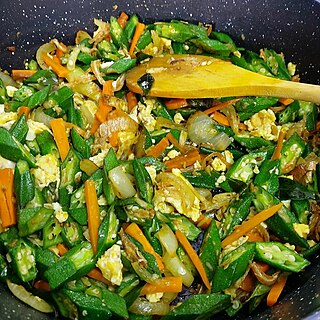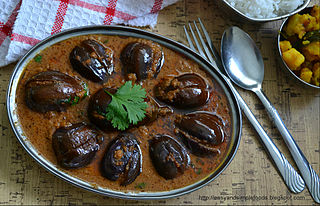Indian cuisine consists of a variety of regional and traditional cuisines native to the Indian subcontinent. Given the diversity in soil, climate, culture, ethnic groups, and occupations, these cuisines vary substantially and use locally available spices, herbs, vegetables, and fruits.

Upma, uppumavu, or uppittu is a dish originating from the Indian subcontinent, most common in Kerala, Andhra Pradesh, Tamil Nadu, Telangana, Karnataka, Maharashtrian, and Sri Lankan Tamil breakfast, cooked as a thick porridge from dry-roasted semolina or coarse rice flour. Various seasonings and/or vegetables are often added during the cooking, depending on individual preferences.

Sadya is a meal of Kerala origin and of importance to all Malayalis, consisting of a variety of traditional vegetarian dishes usually served on a banana leaf in Kerala as lunch. Sadya means banquet in Malayalam. Sadya is typically served as a traditional feast for Onam, the state festival of Kerala and Vishu.

Tamil cuisine is a culinary style of Tamil people originating in the southern Indian state of Tamil Nadu and neighboring Sri Lanka. Meats, along with rice, legumes, and lentils, are also popular. Dairy products and tamarind are used to provide sour flavors. On special occasions, traditional Tamil dishes are served in a traditional manner, using banana leaves in place of utensils. After eating, the banana leaves are then used as a secondary food for cattle. A typical breakfast meal consists of idli or dosa with chutney. Lunch includes rice, sambar, curd, kuzhambu, and rasam.

Penang cuisine is the cuisine of the multicultural society of Penang, Malaysia. Most of these cuisine are sold at road-side stalls, known as "hawker food" and colloquially as "muckan carts". Local Penangites typically find these hawker fares cheaper and easier to eat out at due to the ubiquitousness of the hawker stalls and that they are open for much of the day and night. Penang island. On February 22, 2013, Penang was ranked by CNN Travel as one of the top ten street food cities in Asia. Penang has also been voted by Lonely Planet as the top culinary destination in 2014.

Levantine cuisine is the traditional cuisine of the Levant, in the sense of the rough area of former Ottoman Syria. The cuisine has similarities with Egyptian cuisine, North African cuisine and Ottoman cuisine. It is particularly known for its meze spreads of hot and cold dishes, most notably among them ful medames, hummus, tabbouleh and baba ghanoush, accompanied by bread.

Kerala cuisine is a culinary style originated in the Kerala, a state on the southwestern Malabar Coast of India. Kerala cuisine offers a multitude of both vegetarian and non-vegetarian dishes prepared using fish, poultry and red meat with rice as a typical accompaniment. Chillies, curry leaves, coconut, mustard seeds, turmeric, tamarind, asafoetida and other spices are also used in the preparation.

Indian breads are a wide variety of flatbreads and crêpes which are an integral part of Indian cuisine. Their variation reflects the diversity of Indian culture and food habits.

Madras curry or Madras sauce is a fairly hot curry sauce. Madras is orange in colour and is made with heavy use of chili powder. Raita is often used as an accompaniment to the dish.

Pachadi refers to a traditional South Indian fresh pickle served as a side dish. Roughly translated, it refers to a plant which has been pounded or crushed.
Bhojpuri cuisine is a style of food preparation common among the Bhojpuri people of Bihar and eastern Uttar Pradesh in India, and also the Terai region of Nepal. Bhojpuri foods are mostly mild and tend to be less hot in terms of spices used. The cuisine consists of both vegetable and meat dishes.

Poha, also known as pauwa, sira, chira, chivda, avil or avalakki, among many other names, is flattened rice originating from the Indian subcontinent. Rice is parboiled before flattening so that it can be consumed with very little to no cooking. These flakes of rice swell when added to liquid, whether hot or cold, as they absorb water, milk or any other liquids. The thickness of the flakes varies from almost translucently thin to nearly four times thinner than a normal rice grain.

Ariselu or Arisa is an Indian sweet from Andhra Pradesh, Odisha, Telangana. It is also called Kajjaya in Kannada, Adhirasam in Tamil Nadu, Neyyappam in Kerala ,Anarsa in Marathi, arsa or anarsa in Uttarakhand, Bihar and Jharkhand.

Poṟiyal is a Tamil word for any fried, or sometimes sautéed, vegetable dish. It is called palya in Kannada, vepudu in Telugu, and mezhukupuratti in Malayalam. It is usually made by shallow frying shredded or diced vegetables and greens along with spices. The preparation would normally involve frying mustard seeds, urad dal, onions and then the main vegetable, and finally adding turmeric, various spices, dried red chillis, and coriander. In Tamil Nadu, shredded coconut would be added as a dressing. All poṟiyals by default have some vegetables and lentils or greens, but many variations of the main vegetable exist.

Baigan (बैगन) bharta or Baigan Chokha is an Indian dish prepared by mincing grilled eggplant (baigan) and mixing it with tomato, onion, herbs and spices. Grilling the eggplant over charcoal or direct fire infuses the dish with a smoky flavour. Mashed eggplant is then mixed with cooked chopped tomato, browned onion, ginger, garlic, cumin, fresh cilantro, chili pepper, and mustard oil or a neutral vegetable oil. Traditionally, the dish is often eaten with flatbread and is also served with rice or raita, a yogurt salad. In Bihar and Uttar Pradesh, it is served hot with litti or baati.
Bihari cuisine is eaten mainly in the eastern Indian state of Bihar, as well as in the places where people originating from the state of Bihar have settled: Jharkhand, Eastern Uttar Pradesh, Bangladesh, Nepal, Mauritius, South Africa, Fiji, some cities of Pakistan, Guyana, Trinidad and Tobago, Suriname, Jamaica, and the Caribbean. Bihari cuisine includes Bhojpuri cuisine, Maithil cuisine and Magahi cuisine.

Kuḻambu, is a common dish in Tamil Nadu and Sri Lankan cuisines, and is a tamarind-based dish that can include a variety of meat, vegetables, and in some cases, dal.

Malaysian Indian cuisine, or the cooking of the ethnic Indian communities in Malaysia, consists of adaptations of authentic dishes from India, as well as original creations inspired by the diverse food culture of Malaysia. Because the vast majority of Malaysia's Indian community are of South Indian descent, and are mostly ethnic Tamils who are descendants of immigrants from a historical region which consists of the modern Indian state of Tamil Nadu and Sri Lanka's Northern Province, much of Malaysian Indian cuisine is predominantly South Indian inspired in character and taste. A typical Malaysian Indian dish is likely to be redolent with curry leaves, whole and powdered spice, and contains fresh coconut in various forms. Ghee is still widely used for cooking, although vegetable oils and refined palm oils are now commonplace in home kitchens. Before a meal it is customary to wash hands as cutlery is often not used while eating, with the exception of a serving spoon for each respective dish.

The Thalassery cuisine refers to the distinct cuisine from Thalassery town of northern Kerala, which has blended in Arabian, Persian, Indian and European styles of cooking as a result of its long history as a maritime trading post.

Maithil cuisine, also known as Mithila cuisine, is a part of Indian and Nepalese cuisine. It is the traditional cooking style of Maithils residing in the Mithila region of the subcontinent.

















